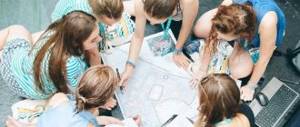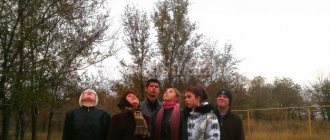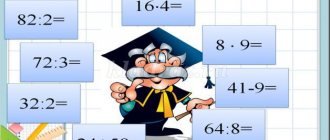Master class on developing students' creative abilities
Slide 0
Master class on developing students' creative abilities
Slide 1
Introduction The most valuable quality in life is eternally youthful curiosity, unquenched by years and reborn every morning R. Rolland
Slide 2
Any knowledge remains dead if students do not develop initiative and initiative, the desire for science: students need to be taught not only to think, but also to want N.A. Umov
Slide 3
Global changes in the information, communication, professional and other spheres of modern society require adjustments to the content, methodological, and technological aspects of education, a revision of previous value priorities, targets and pedagogical means.
Slide 4
The changes currently taking place in social life require the development of new methods of education, pedagogical technologies that deal with individual personal development, creative initiative, the skill of independent advancement in information fields, the formation in the student of a universal ability to set and solve problems to resolve problems that arise in life - professional activity, self-determination, everyday life.
Slide 5
The emphasis is shifted to the education of a truly free personality, the formation in children of the ability to think independently, obtain and apply knowledge, carefully consider decisions and clearly plan actions, effectively collaborate in groups of diverse composition and profile, and be open to new contacts and cultural connections. This requires widespread introduction into the educational process of alternative forms and methods of conducting educational activities.
Slide 6
Both family and school are involved in solving these problems. The task of the family is to see in time, discern the child’s abilities, pay attention to them and understand that these abilities need support and development. The task of the school is to take up the initiative of the family, support the child and develop his abilities, prepare the ground for these abilities to be realized not only in class and extracurricular activities, but also subsequently, in future professional activities.
Slide 7
Today, it is becoming more and more obvious that social progress largely depends on how many creative people are able to carry it out. The development of science, technology, and production depends on the degree of development of the creative principle in a person.
Slide 8
A person with a creative type of thinking quickly adapts to various living conditions, finds non-standard solutions to any problems that arise, is able to adequately evaluate his results and, having made mistakes on his creative path, is able to correct them.
Slide 9
Life itself puts forward an urgent practical task - the education of a creative person, creator and innovator, capable of solving emerging social and professional problems in an unconventional, proactive and competent way.
Slide 10
Speaking about the problem of creative abilities, it is necessary to remember that creativity is impossible without activity, and productive activity. This is exactly what the great scientist L.S. said. Vygotsky when he wrote: “Creativity in fact exists not only where great historical works are created, but also everywhere where a person imagines, combines, changes and creates something new, no matter how small this new thing may seem in comparison with the creations geniuses."
Slide 11
Chapter 1. Creative student. What is he like? Knowledge is made up of small grains of D.I.’s daily experience. Pisarev
Slide 12
The student became more aware, relaxed, more questioning, demanding, and proactive. This is due both to the fact that the world around us has changed, and to the fact that the conditions for raising a child in the family have changed. Today's family initially places the child in conditions in which he undoubtedly must prove himself. The demands of the family force the child to be proactive in educational activities, to participate in a wide variety of types of educational and additional knowledge, which, gradually, leads to the habit of expressing himself creatively.
Slide 13
The main conditions for the mental development of younger schoolchildren: Increased impressionability and suggestibility The desire to imitate the actions and statements of adults The desire to repeat what aroused interest, curiosity, positive emotions
Slide 14
The types of activities offered to schoolchildren can be the following: Intellectual marathons Small educational Olympiads Intellectual Olympic Games Creative intellectual competitions Family intellectual brain rings Intellectual projects “I work as a wizard” Open day “We invite you to visit” Intellectual clubs Circles and classes on the interests of students and etc.
Slide 15
The development of intelligence in adolescence (11-15 years) is closely related to the development of creative abilities. It lies in the fact that the student must be prepared by studying in elementary school not only to master new educational material, but also to create subjectively new things, to demonstrate intellectual initiative and curiosity.
Slide 16
The peak of intellectual development is reached by a student at the age of 12. However, this does not mean that the creative process ends with 12 years, it is just beginning. It is at this age that a conscious manifestation of interest in independent intellectual activity begins, the need for one’s own research into processes and phenomena, the desire to prove the problems being solved, perseverance in achieving intellectual skills, and the need for active creative activity.
Slide 17
L.S. Vygotsky O.
Slide 18
High school students are distinguished by the fact that they discover their inner world and determine its content. the content of a high school student’s inner world is directly related to the future for which he is preparing himself. It is this future that determines his passions, interests, needs, and attachments. High school students feel a need for people whose skills and achievements they would like to follow in their lives.
Slide 19
A feature of the mental activity of high school students is that the children activate their theoretical thinking, manifest a desire to independently discuss theoretical positions and conclusions, and strive to reach the truth in a particular issue.
Slide 20
Problem-based lessons, discussion lessons, lessons - interactive games, debate lessons - this is the field that will help a high school student increase not so much interest as the need and habit for creative and intellectual activity.
Slide 21
Answers of high school students to the question: “What do you mean by the concept of “Interesting lesson?” For me, an interesting lesson is the opportunity to solve a given problem independently or with a group of children. Independent work gives you the opportunity to test yourself, your abilities, conclusions, conclusions. I am always interested when a lesson gives me the opportunity to plan my progress in a particular topic, when the teacher uses types of work that correspond to my capabilities and skills. Marina K., 17 years old
Slide 22
It is not for nothing that the great Socrates said, “that a person can only comprehend what he has come up with himself, and the search for truth is possible only in a free exchange of opinions.”
Slide 23
Chapter 2. The role of psychological services in organizing student research work
Slide 24
The psychological service of the school can and should provide great assistance in organizing and developing scientific research work in the school. The psychological service of the school must show the student the conditions of the school for the development of his creativity.
Slide 25
Research: 1. This academic year I want to participate in: Olympiads NOU work Intellectual marathon Educational expedition Elective work Club work Competition Work of a special course Project preparation.
Slide 26
2. For this purpose, I choose: Olympiad on ________________________________ Research topic on _________ Educational expedition ________________________ Elective ________________________________ Club _________________________________ Participation in the project ___________________________ Special course ___________________________
Slide 27
3. To achieve results, I need help from the Administration_____________________________ School psychologist___________________________ Class teacher______________________ Subject teacher______________________________ Outside school consultant_____________________
Slide 28
Intellectual activity examples of intellectual activities with student members of non-governmental educational institutions The system of classes is aimed at developing the intellectual skills of students. Each lesson is designed to set specific tasks that will help students take a fresh look at their own intellectual activity, evaluate the achievements of people who have had enormous success in science, art, etc.
Slide 29
Lesson Objectives of the lesson: 1. Develop students’ linguistic skills: construct a coherent statement, give a logical and consistent answer. 2. Learn to listen to others and yourself. 3. Develop students' creative abilities.
Slide 30
Progress of the lesson I. Systematization exercise Words are written in disarray on the board. Students need to distribute these words into groups under the general concept. Find this general concept. Cow, chemistry, sofa, September, beets, pen, pig, physics, bed, June, potatoes, pencil, sheep, mathematics, ottoman, July, cabbage, notebook, horse, history, sofa, August, carrots, pencil case. Task completion time – 2 minutes.
Slide 31
II. A minute of reflection Words are written on the board in three columns. Students need to write its antonym (the word opposite in meaning) next to the words in 3 minutes. High... rarely... expand... Beginning... remember... best... White... joy... hesitate.. Buy... harmful... wet... Top... profit... center... Senior... small... condemn... Later... offer... protection... Hostility... damage... together... Pure ...quarrel...forbid...Drop...frankness...highest...Along...internal...empty...Help...dismiss...doubt...Courage...cruel...idle...
Slide 32
III. Compiling a collective story on this topic The topic of the story is written on the board. Each student names one sentence. Each subsequent sentence is a continuation of the story. The task is completed quickly, without much thought. Execution time – 10 minutes.
Slide 33
IV. Compiling a story using reference words To compose a story, the words girl, suit, flower, key, crocodile, ship, earth, sun, joy, pleasure are written on the board. Each student is asked to compose his own story using the words provided. Each sentence must use one word. All stories are read and their merits and demerits are determined. Requirements for writing stories: Logicality Completeness Presence of a storyline Use of a variety of linguistic means to write a story.
Slide 34
Homework Compose a story with the words suggested above, using different literary genres: Humorous Detective Historical Journalistic
Master class on developing creativity
Irina Zaraiskaya
Master class on developing creativity
Goal: To create conditions for expanding teachers’ knowledge about the development of creative abilities of preschoolers .
Tasks:
Reveal the meaning of creativity for children .
Teach teachers to use methods and techniques that develop creativity in children .
Reveal the main components of creative abilities .
To increase the professional competence of educators in matters of developing the creative abilities of preschoolers .
Develop the creative abilities of teachers through game exercises.
Look at the photo (Slide)
What unites these people? (photos of celebrities on the slide)
/athlete, musician, fashion designer, artist, intellectual/
They have certain natural gifts or vocation, skill, talent, genius;
For example: Einstein the genius
Kabaeva - skill
Gazmanov - talent
Yudashkin - calling
Nikas Safonov - talent
Today we will talk about the state, quality, property that makes it possible to perform certain actions, perform this or that work. Natural giftedness, talent, i.e. abilities .
There are many professions in which a person shows his abilities .
Name these professions. (participants name)
One of them is a teacher.
Tell me, what abilities does the teacher have? (answers from the audience: creativity, kindness, communication, mobility)
Working with the hall:
Do you want to make sure that we are creative people ?
(airplane sound)
-Imagine that we are flying with you on an airplane. From a bird's eye view we see such an object (circle on the slide)
What is this item?
(hall options)
-We look at this object from above. If the audience is at a loss, a “YES-NO”
(explains the rules).
Participants come to the conclusion that this is a vase.
-Well done! This confirms that you are creative people .
Slide (definitions of
a creative person , 2 pieces) A creative person is……
. …. ...
a creative person is an original thinking person capable of non-standard solutions.
Working with the audience.
- Now please tell me how he can apply it in his professional activities?
-cook
-hairdresser
-architect
-perfumer
-This once again confirms that you are creative , creative people.
-I invite 4 creative people to the stage .
1. task for the first pair
I invite creative people to the stage :
1. task…. (one copy distributed)
The successful development of creative abilities is possible only when certain conditions are created that are conducive to their formation. The task is to select the necessary conditions:
1. Rational approach to reality (weakening the role of fantasy)
.
2. Creating an environment that advances the child’s development .
3. Development of social and everyday skills
4. Giving the child freedom in choosing activities, alternating tasks, duration of activities, etc.
5. Restriction by adults of a child’s freedom to choose activities.
6. Smart, friendly help (not a hint)
adults.
7. Turn freedom into permissiveness, and help into a hint
8. Comfortable psychological environment, encouragement by adults of the child’s desire for creativity .
2. The task is to create a product of our imagination (for the second pair of participants)
Game "Limpopo"
4 wild animals are offered, (write zebra, wolf, elephant, fox)
Assignment: draw a fragment of each of the proposed animals, create a new animal from these fragments (draw and name it.
Answer the question: Where can this animal live?
-Thank you for your participation. Join your colleagues.
While the sections are working on stage, work is being done with the audience.
Working with the audience
-In what types of activities can creativity ?
(answers from the audience)
Creativity also manifests itself in theatrical activities.
A game is being played with the hall “Onomatopoeia”
-You know how to express your creativity in theatrical activities.
-And now I suggest you look at the screen. What word is encrypted here?
Slide with the rebus “Home”
— I suggest you come up with non-existent words for pine “house”
.
The game “Word Formation”
-Well done! word creativity here too .
-It's time to address the participants who are working on stage.
Working with the audience
-In conclusion, I offer you one more game.
Slide showing houses.
A game is being played to develop the imagination “Who can live in this house?”
— What kind of animal do you think can live in house number 1? We offer 4 animals (giraffe)
(response from the audience)
- Well done!
Summarizing
Creativity is a person’s ability to find a special perspective on familiar and everyday things or tasks.
Don't be afraid to show your CREATIVITY !





